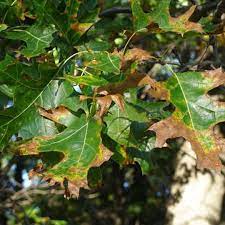Oak trees are not only majestic additions to landscapes but also play a crucial role in supporting biodiversity. However, these iconic trees face a significant threat known as oak wilt, a deadly disease caused by the fungus Ceratocystis fagacearum. Once infected, the disease can spread rapidly, leading to the decline and death of the oak tree. One preventive measure that arborists and homeowners alike can take is pruning oak trees in winter.
 Oak wilt is a vascular disease that affects the water-conducting vessels of oak trees, disrupting the flow of water and nutrients. The fungus is primarily spread by sap-feeding beetles attracted to fungal mats produced on infected trees. Additionally, the disease can be transmitted through root grafts between neighboring oak trees. Once an oak tree is infected, there is no cure, making prevention through proper tree care practices essential.
Oak wilt is a vascular disease that affects the water-conducting vessels of oak trees, disrupting the flow of water and nutrients. The fungus is primarily spread by sap-feeding beetles attracted to fungal mats produced on infected trees. Additionally, the disease can be transmitted through root grafts between neighboring oak trees. Once an oak tree is infected, there is no cure, making prevention through proper tree care practices essential.
Pruning oak trees in winter is a key strategy in preventing the spread of oak wilt. Winter is the dormant season for many trees, including oaks, meaning they are not actively growing. This dormancy reduces the likelihood of attracting sap-feeding beetles that could transmit the disease during pruning.
Winter pruning should be performed during the dormant period, typically between November and March when the sap flow is minimal. Avoid pruning during the growing season, as fresh wounds attract sap-feeding beetles that could inadvertently spread the disease.
Tools used for pruning should be sterilized between cuts and between trees to prevent the transmission of the fungus. A mixture of 10% bleach or alcohol solution is effective in killing the oak wilt fungus. When pruning, prioritize the removal of dead or diseased branches, as these are more susceptible to oak wilt. Removing these materials reduces the risk of fungal infection and helps improve the overall health of the tree.
After pruning, seal the wounds with a tree wound dressing to prevent sap-feeding beetles from being attracted to the fresh cuts.
Proper wound care is crucial in reducing the risk of oak wilt transmission. For larger oak trees or extensive pruning needs, it’s advisable to seek the assistance of a certified arborist. These professionals are trained to assess the health of oak trees and perform necessary pruning without compromising the tree’s well-being.
In conclusion, pruning oak trees in winter is a proactive measure to protect these iconic trees from the devastating effects of oak wilt. By understanding the disease, following best practices for winter pruning, and taking necessary precautions, homeowners and arborists alike can contribute to the preservation of oak trees and the ecosystems they support.
